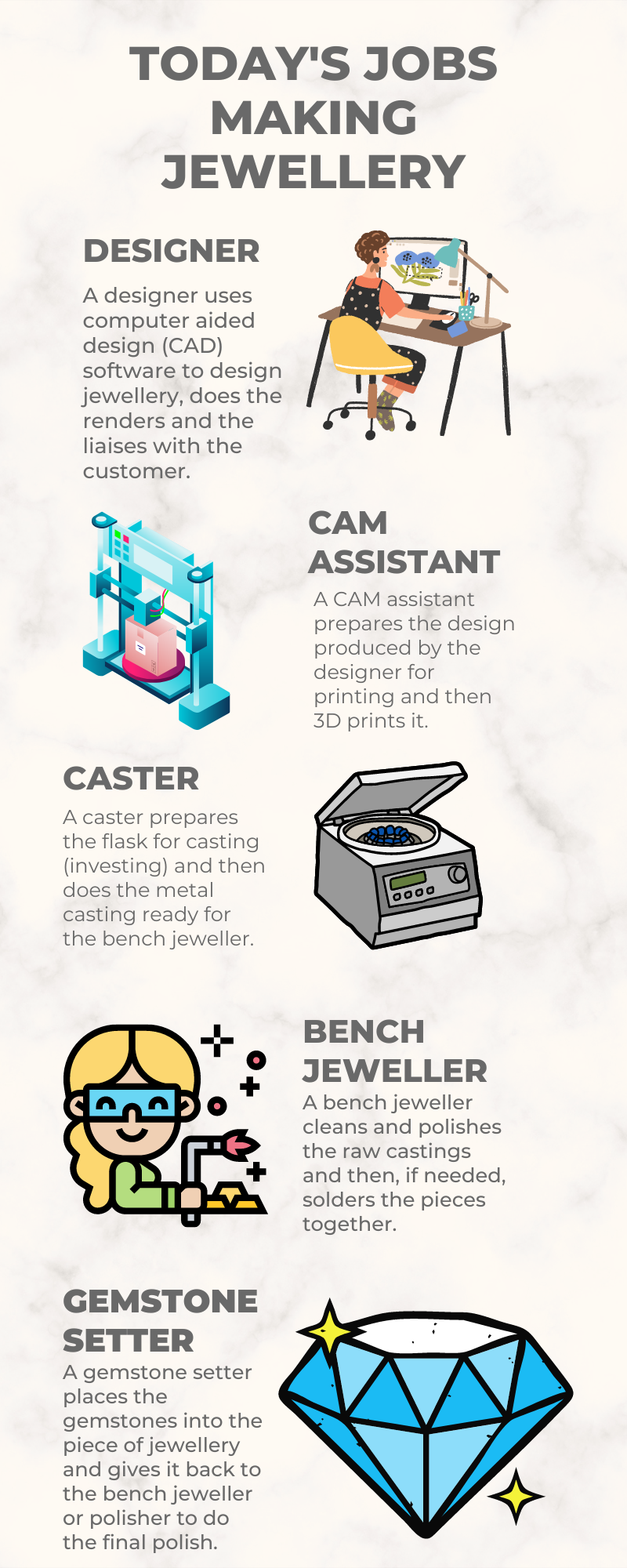If you Google “how to become a jeweller”, you will get plenty of results saying the exact same thing – that is you need to do an apprenticeship. This usually takes four years, apprenticeship openings are virtually nil, especially in states like Western Australia, and to top it all off, apprenticeship wages are a pittance. However, thanks to technological changes and shifting customer demands, nowadays an apprenticeship, for the most part isn’t the best option to become a jeweller.
Back in 2008, I wrote about cast vs handmade engagement rings. Back then, we made 99% of our jewellery by hand. This required a lot of bench jeweller labour, and as such, we had a workshop of seven to eight jewellers and setters. All these jewellers were trained with formal or informal apprenticeships. Fast forward almost 15 years, and the way we, and I would say most of the industry, make jewellery has changed dramatically.
The Process of Making Jewellery Today
Whilst I certainly don’t speak for the whole industry, the process of making a bespoke engagement ring or other piece of jewellery has changed dramatically in the last 20 years. The traditional way was to do the design by hand and then give this design on a sheet of paper to a jeweller who would then either handmake the piece or carve a wax, cast it and the clean and assemble the casting. Any gemstones would then be set by a setter who would give it back to the bench jeweller or specialist polisher to polish.
However, unlike any other industry outside the technology sector, the process of manufacturing jewellery has dramatically changed. As in the example below, a designer first designs the piece of jewellery, the CAM assistant prepares it for the caster, who then casts it and gives it the bench jeweller and setter.

Above: Jobs Needed to Manufacture Jewellery Today
As you can imagine, using modern day processes, the focus is now shifted from bench jewellers and setters to the jewellery designer. From a customer perspective, this is a good thing, as the customer has a lot of say in the design, and the design is replicated almost exactly because it is 3D printed, hence design elements are not left up to the dreaded “jeweller’s discretion”. However, despite looking on the face of it, a lot easier and less time consuming, in my experience, it is just as, if not more time consuming most of the time than handmaking – it’s just that the labour is shifted away from the jeweller to the jewellery designer.
How To Become A Modern Day Jeweller
Firstly, there’s a big difference between making jewellery as a hobby and pursuing it as a full time profession. Making jewellery as a hobby and selling it on sites like Etsy or at local markets may well be fun and fulfilling, however, making jewellery worth potentially hundreds of thousands of dollars and interacting with a range of clients from all walks of life is a different kettle of fish. In my experience, around 50% of apprentices that complete their apprenticeship stay on in the industry as a jeweller in the long term. Those that don’t stay on either pursue better paying careers in other industries, content with jewellery making as a hobby, or, come back to the jewellery industry at a later date. Therefore, whether you’re young or old, it is important before you commit yourself and an employer to a four year apprenticeship.
One of the best ways to gain experience in the jewellery industry is to work in a retail environment. Working in a retail shop will not only give you generic customer service skills, but you will expose you to the inner workings of the jewellery industry. Whilst most job postings are from chain stores like Michael Hill or Prouds, smaller independent stores, especially those that do their own design and manufacturing offer much better opportunities to learn as they have all sorts of different people working there such as jewellers, setters, salespeople and gemmologists, just to name a few.
In terms of learning how to design and make jewellery, like a lot of things nowadays, it can be done online and with not much capital outlay.
To learn to make jewellery, I would recommend Jewellery Training Solutions as they have a number of videos for beginners through to advanced jewellery making videos, as well as videos about tools and techniques. Tools can also be bought cheaply from EBay or AliExpress meaning you can even setup your own workshop on a budget.
To learn to design jewellery, I would recommend PJ Chen’s Youtube channel and learning about production standards from Stuller’s Productions Standards. The most popular software for jewellery design is Rhinoceros, which can be bought from US$195.

Above: Rhinoceros Jewellery Design Software
As you can see, becoming a jeweller, working as a jeweller for any length of time and more importantly, making money in this industry has many different pathways. Gone are the days of so-called “top” jewellers who can charge a premium for making what may be a simple piece of jewellery, as diamond commoditisation and CAD/CAM have now made the industry a level playing field. In my experience, the most successful people in this industry are the ones with a broad knowledge base and are multi-skilled, combined with good customer service skills.